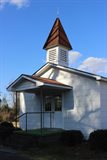
Penderlea was the first New Deal farming community authorized by President Franklin Delano Roosevelt. Proposed by Hugh MacRae, Penderlea was designed to give unemployed and tenant farmers 10-acres, a home, a barn, electricity and running water.
“The hope was that families could make a living on the farm,” said Ann Southerland Cottle who was raised in Penderlea.
“Our family came to Penderlea when I was 4 years old,” said the retired educator who wrote “The Roots of Penderlea,” a book about the community.
“We’re a close community,” said Cottle. “We worked together.”
Cottle said families that wanted to come to Penderlea had to apply. One of the criteria on the application was a letter from the family pastor.
“But once we got to Penderlea, there was no church,” said Cottle.
In 1936 families organized the first church, meeting in the former barracks where the construction workers stayed when Penderlea was being built. Sunday school was organized in 1937.
It was from the popular Sunday school that the Community Church was organized in 1940, Cottle recalled.
The first pastor was Rev. William Burris, who lived on the Penderlea development. After Burris’ tenure, a retired Presbyterian minister started serving the Penderlea Community Church.
Cottle described Potts as a true Southern gentlemen who was highly respected by Penderlea’s homesteaders. With a head full of white hair and a mustache, he was a grandfather figure to the children of Penderlea, she said.
While Potts was a Presbyterian, the church’s seed money was originally given by Methodist, Episcopal and Presbyterian mission boards. The church was essentially non-denominational until the congregation disagreed over methods of baptism. The congregation agreed it was time to select a denomination and they put the decision before the flock in 1945. The congregation voted between Baptist, Methodist, and Presbyterian.
A vote was taken and no denomination captured the majority. A second ballot was cast. This time the Presbyterians were selected by a majority vote.
A month later, the Penderlea Community Church was named Potts Memorial Presbyterian Church.
Sadly, Rev. Potts died a few months later.
Rev. Ben Brown, a retired Navy chaplain, was called to lead the new flock.
The first church building at 4125 NC Hwy. 11 was purchased from Fort Fisher. The military chapel cost $125. The building was disassembled and moved to the Penderlea. Guy Hadnott supervised the re-construction.
The rebuilt church needed a new roof, wiring, and children’s classrooms were portioned off.
The church building was completed on Sept. 13, 1946. At 5 p.m. that day, Eva Mae Rogers married Harold Lane.
“It looks very much the same as when it was first used here,” said Cottle.
Beyond the main sanctuary are children’s classrooms.
“The woodwork is the same,” said Cottle.
But less than two years later, the church had outgrown the former Fort Fisher chapel. They turned to Guy Hadnott again, this time with their eye on a chapel at Camp Davis.
“Look at this,” Cottle pointed to an archway in the Potts Memorial Presbyterian Church. “Guy Hadnott identified each board as the Camp Davis chapel was dismantled.”
The church, with its beautiful exposed wood beams, was completed June 1949.
“Look at the woodwork,” Cottle said. “You see dogs in the grain of the wood.”
Amazingly, in the wood grain is the face of Spaniel . There are others with longer snouts.
On sunny days, the sanctuary is filled with warm yellow light, cast by the tall windows.
“It’s a beautiful old church,” said Cottle.
Next door to Potts Memorial Presbyterian is the church cemetery. Buried in the cemetery is the Picford family, the owners of land’s original plantation. The large grave markers are broken by tree roots, but the dates are still visible. Isabella Picford, the wife of Edward, died in 1856, more than 160 years ago.
Penderlea is filled with history – and not just history from the Great Depression. Penderlea Homestead Museum preserves the history of people who persevered, who built schools, churches, and a museum.
The Penderlea Homestead Day is set for April 23, 11 a.m. – 3 p.m. Be sure to take a drive out Penderlea Hwy. and visit the history of a community.



